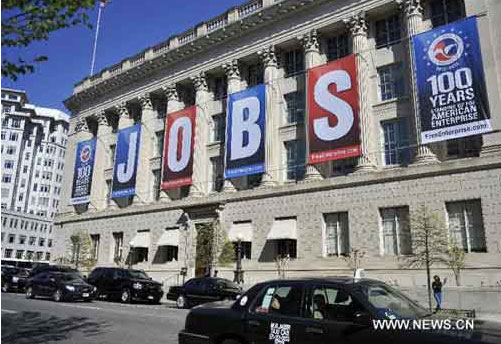U.S. jobless rate ticks down in March, job gains decelerate
The U.S. unemployment rate edged down 0.1 percentage point to 8.2 percent in March, with job growth stalled, refreshing worries that the current economic growth may not be strong enough to bring sustained labor market improvement.
The jobless rate slightly fell to 8.2 percent in March from 8.3 percent in February, the lowest rate since January 2009. It has been steadily declining since August 2011, when it was 9.1 percent.
Meanwhile, job growth slowed to 120,000, sharply lower than
the average monthly increase of 246,000 in the prior three months. The private
sector added 121,000 jobs, while the government slashed 1, 000 jobs. 
Banners of "jobs" are seen on the Chamber of the United States Commerce in Washington D.C., capital of the United States, April 6, 2012. The U.S. unemployment rate dropped slightly to 8.2 percent in March, the lowest level since January 2009, but employers slowed down on hiring, the Labor Department said on Friday. (Xinhua/Zhang Jun)
Many industries including manufacturing, health care, hospitality reported job growth, but construction and retail trade shed jobs, dragging down the overall net job increase in private sector.
"The economy has added private sector jobs for 25 straight months, for a total of 4.1 million jobs over that period," said Alan Krueger, chairman of the council of economic advisers.
However, the number of unemployed Americans was little changed at 12.7 million in March. More than 5.3 million Americans, or 42.5 percent of the unemployed, had been out of work for more than six months, virtually unchanged from the previous month.
The retreat on employment in March backed the cautious remarks of the U.S Federal Reserve (Fed) Chairman Ben Bernanke. He indicated last week that recent pick up in monthly payroll gains and decline in the unemployment rate would only reflected a reverse of the unusual large layoffs triggered by the severe financial crisis during 2008 and 2009. In his view, continued accommodative policies would help boost more rapid recovery, providing support for further improvement in labor market.
Although Bernanke held that for now cyclical factors like weak demand, rather than structural ones, are the main reasons for the long-term unemployment, some economists argued that in the wake of a severe recession, the lines between cyclical and structural unemployment can be blurred.
In March, the labor force participation rate, which measures the share of the working-age population working or looking for jobs, fell slightly to 63.8 percent, with about 333,000 more people dropped out of the labor force.
"The unemployment rate fell because fewer jobless workers were actively seeking a job, not because more Americans found one," said Gary Burtless, a senior fellow at Brookings Institution, a Washington-based think tank. "After six months of robust job gains, a mediocre report in March may signal the start of slower improvements in the next few months."
U.S. President Barack Obama, whose reelection hopes may influenced by the performance of the labor market, while welcoming the drop of the jobless rate, said that the labor market would still face "ups and downs" and a lot more work needs to be done.
(VietNamNet/Xinhuanet)
- Cuban media highlighted Vietnamese Party leader Nguyen Phu Trong’s contributions (21/07)
- Five people survive after helicopter crashes in Indonesia (20/07)
- Cyanide found in food of 6 dead Vietnamese, American citizens in Thailand (20/07)
- Singapore approves RSV vaccine for people aged from 60 (19/07)
- Green investment strategy expected to boost Malaysian economy (18/07)
- Conflict with Hamas takes toll on Israel's economy (17/07)
- Bad debts in housing hinder Thailand's economic growth (17/07)
- Efforts made to promote digital payment integration in ASEAN (16/07)
 Cuban media highlighted Vietnamese Party leader Nguyen Phu Trong’s contributions
Cuban media highlighted Vietnamese Party leader Nguyen Phu Trong’s contributions
 Cyanide found in food of 6 dead Vietnamese, American citizens in Thailand
Cyanide found in food of 6 dead Vietnamese, American citizens in Thailand
 Five people survive after helicopter crashes in Indonesia
Five people survive after helicopter crashes in Indonesia
 Singapore approves RSV vaccine for people aged from 60
Singapore approves RSV vaccine for people aged from 60
 Green investment strategy expected to boost Malaysian economy
Green investment strategy expected to boost Malaysian economy
 Bad debts in housing hinder Thailand's economic growth
Bad debts in housing hinder Thailand's economic growth
 Conflict with Hamas takes toll on Israel's economy
Conflict with Hamas takes toll on Israel's economy
 Efforts made to promote digital payment integration in ASEAN
Efforts made to promote digital payment integration in ASEAN
KPL praises President To Lam's visit as boost to bilateral ties
 Thailand’s consumer confidence slips in June
Thailand’s consumer confidence slips in June



